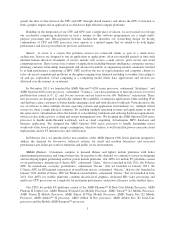AMD 2011 Annual Report Download - page 21
Download and view the complete annual report
Please find page 21 of the 2011 AMD annual report below. You can navigate through the pages in the report by either clicking on the pages listed below, or by using the keyword search tool below to find specific information within the annual report.As is typical in the semiconductor industry, we have numerous cross-licensing and technology exchange
agreements with other companies under which we both transfer and receive technology and intellectual property
rights. One such agreement is the cross-license agreement that we entered into with Intel on November 11, 2009,
in connection with the settlement of our litigation. Under the cross license agreement, Intel has granted to us and
our subsidiaries, and we have granted Intel and its subsidiaries, non-exclusive, royalty-free licenses to all patents
that are either owned or controlled by the parties at any time that have a first effective filing date or priority date
prior to the five-year anniversary of the effective date of the cross license agreement, referred to as the “Capture
Period,” to make, have made, use, sell, offer to sell, import and otherwise dispose of certain semiconductor- and
electronic-related products anywhere in the world. Under the cross license agreement, Intel has rights to make
semiconductor products for third parties, but the third party product designs are not licensed as a result of such
manufacture. We have rights to perform assembly and testing for third parties but not rights to make
semiconductor products for third parties. The term of the cross license agreement continues until the expiration
of the last to expire of the licensed patents, unless earlier terminated. A party can terminate the cross license
agreement or the rights and licenses of the other party if the other party materially breaches the cross license
agreement and does not correct the noticed material breach within 60 days. Upon such termination, the
terminated party’s license rights terminate but the terminating party’s license rights continue, subject to that
party’s continued compliance with the terms of the cross license agreement. The cross license agreement and the
Capture Period will automatically terminate if a party undergoes a change of control (as defined in the cross
license agreement) and both parties’ licenses will terminate. Upon the bankruptcy of a party, that party may
assume, but may not assign, the cross license agreement, and in the event that the cross license agreement cannot
be assumed, the cross license agreement and the licenses granted will terminate.
We also have a patent cross license agreement with GF pursuant to which each party granted to the other a
non-exclusive license under patents filed by a party (or are otherwise acquired by a party) within a certain
number of years following the effective date of the agreement. In 2009, under the agreements with GF, we
assigned approximately 3,000 patents and approximately 1,000 patent applications to GF. GF owns its allocation
of patents and applications subject to pre-existing rights, licenses or immunities granted to third parties relating
to such patents and applications. The patents and patent applications to be owned by each party after the division
were licensed to the other party pursuant to the agreement.
In addition, we entered into a Non-Patent Intellectual Property and Technology Transfer Agreement with
GF pursuant to which we assigned to GF all of our right, title and interest in technology and non-patent
intellectual property rights used exclusively in the manufacture, sorting and/or intermediate testing of
semiconductor products. We retained technology and non-patent intellectual property rights used exclusively in
the design and/or post-fabrication delivery testing of semiconductors. Technology and non-patent intellectual
property rights used both in the manufacture, sorting and/or intermediate testing of semiconductor products and
in the design and/or post-fabrication delivery testing of semiconductor products is owned jointly by us and GF.
Backlog
We sell standard lines of products. Sales are made primarily pursuant to purchase orders for current delivery or
agreements covering purchases over a period of time. Some of these orders or agreements may be revised or cancelled
without penalty. Generally, in light of current industry practice, we do not believe that such orders or agreements
provide meaningful backlog figures or are necessarily indicative of actual sales for any succeeding period.
Employees
As of December 31, 2011, we had approximately 11,100 employees.
Environmental Regulations
Many aspects of our business operations and products are regulated by domestic and international
environmental laws and regulations. These regulations include limitations on discharge of pollutants to air, water,
15
























